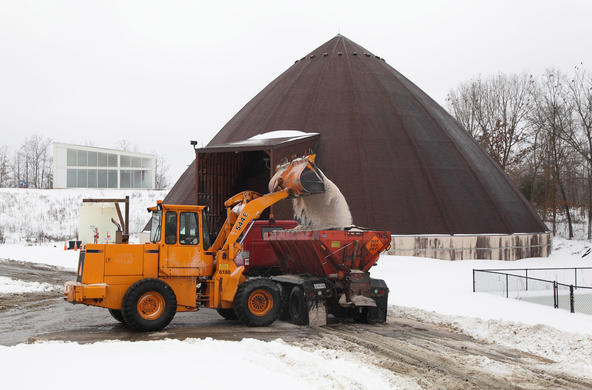North America’s freshwater lakes are getting saltier. The culprits: development and road salt. So reports an extensive study of 371 lakes conducted by a team of researchers in the Global Lake Ecological Observatory Network (GLEON) Graduate Student Fellowship Program, an initiative led by Cary Institute scientist Kathleen Weathers.
Each year, some 23 million metric tons of road salt are applied to North America’s roads to melt away snow and ice. Much of this road salt washes into nearby water bodies, where it is recognized as a major source of chloride pollution to groundwater, streams, rivers, and lakes.
The study is the first large-scale analysis of chloride trends in freshwater lakes. Results reveal that many Midwestern and Northeastern lakes are experiencing increasing chloride levels, with some 44% of lakes sampled in these regions undergoing long-term salinization.
Hilary Dugan, now a limnologist at the University of Wisconsin-Madison, was lead author on the project during her tenure as a Cary Institute Postdoctoral Fellow. She explains, “We were interested in revealing whether, how, and why salinization is changing across North America. The picture is sobering. For lakes, even small amounts of shoreline development translate into big salinization risks.”
In lakes, elevated chloride levels can alter the composition of fish, invertebrates, and the plankton that form the base of the aquatic food web. In extreme cases, salinization can prevent water in lakes from mixing - causing low oxygen conditions that smother aquatic life and reduce water quality.
Thirteen GLEON Fellows took part in the study. They compiled long-term data to identify trends in chloride concentrations in North American lakes and reservoirs, then related these trends to climate and land use changes. Most of the lakes are in the North American Lakes Region, which includes Connecticut, Maine, Massachusetts, Michigan, Minnesota, New Hampshire, New York, Ontario, Rhode Island, Vermont, and Wisconsin.
To gauge road salt exposure, the team assessed road density and land cover within a 100- to 1500-meter buffer around each of the study lakes. Roads, parking lots, and sidewalks are reliable proxies for road salt application because they are susceptible to high levels of salting and runoff.
Results were clear: roads within 500 meters of a lake’s shoreline were a strong predictor of rising salinity. In the North American Lakes Region, 70% of lakes with more than 1% impervious land cover in their 500-meter buffer zone had increasing chloride trends. Extrapolated to all lakes in the North American Lakes Region, some 7,770 lakes may be at risk of rising salinity.
Even more sobering, these results likely underestimate the problem. Many regions with heavy road salt use, such as Quebec or the Maritime Provinces of Canada, had no long-term lake data available. It is also difficult to obtain rates of road salt application.
Weathers concludes, “In the North American Lakes Region - where road salt is a reality - roads and other impervious surfaces within 500 meters of a lake’s shoreline are a recipe for salinization. We need to manage and monitor lakes to ensure they are kept ‘fresh’ and protect the myriad of services they provide, from fisheries and recreation to drinking water supplies.”





